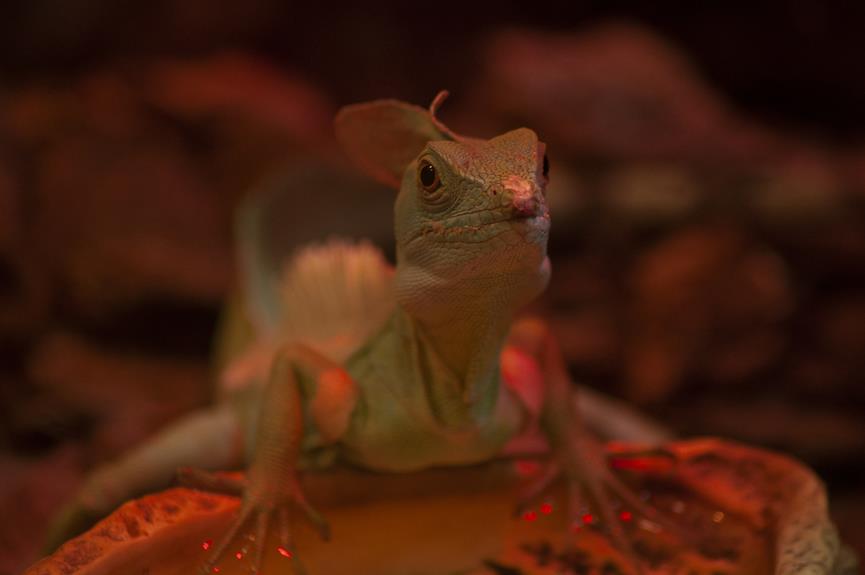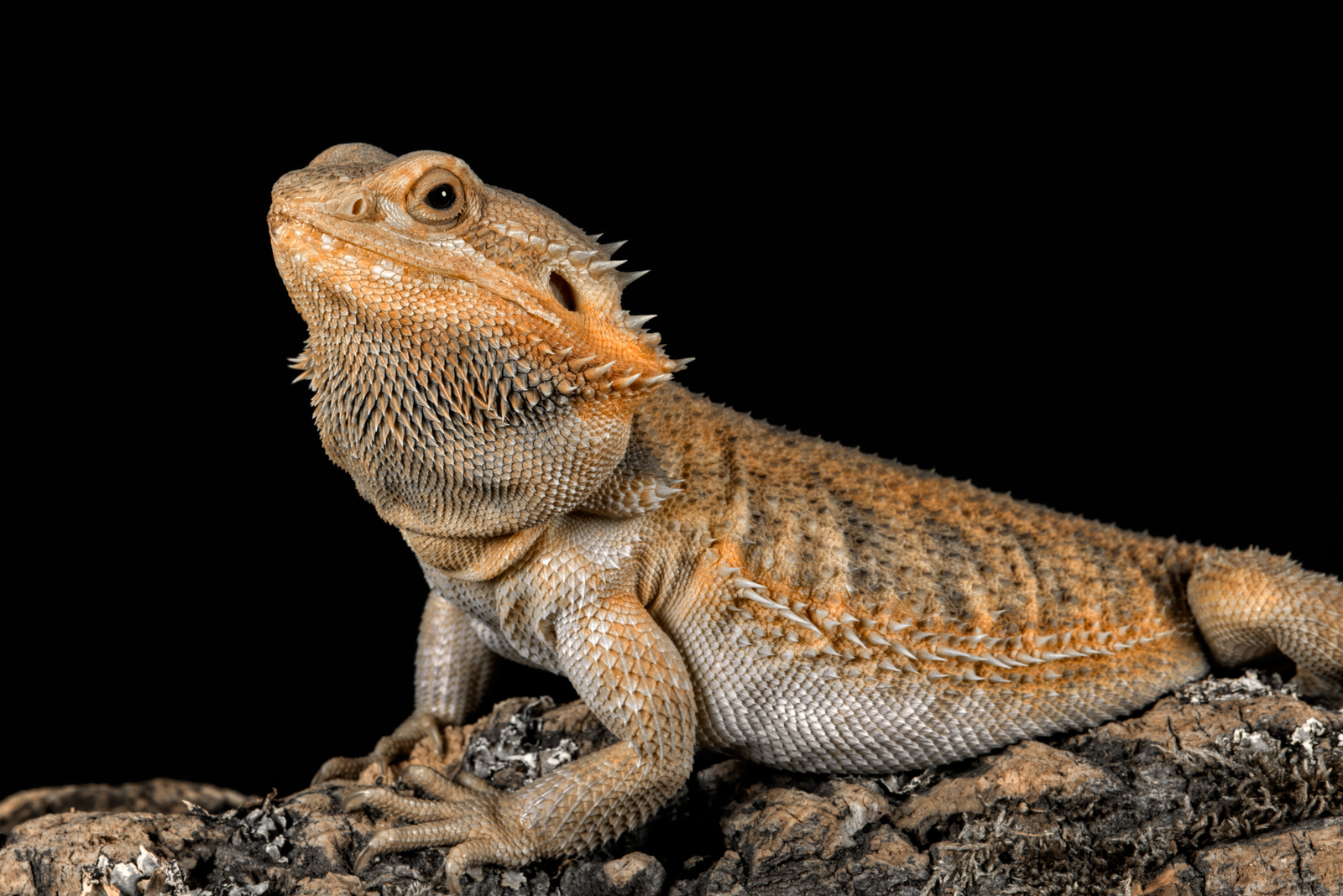If you're looking to delve into the mysterious world of crested gecko breeding, prepare to be captivated by the intricacies of their courtship dance.
In this article, we will guide you through the process of creating the perfect terrarium, selecting compatible pairs, understanding the reproductive journey, and caring for the precious eggs and hatchlings.
Get ready to witness the wonders of romance in the terrarium as we unravel the secrets of breeding crested geckos.
Key Takeaways
- Crested geckos have an elaborate courtship ritual involving signals and displays such as tapping, head movements, and tail wags.
- Maintaining the ideal terrarium conditions including temperature, humidity, hiding spots, and climbing surfaces is important for successful breeding.
- Selecting compatible crested gecko pairs based on genetics, behavior, and temperament is crucial for successful bonding and breeding.
- Understanding the reproductive process, nesting behavior, and proper care during incubation is essential for the successful hatching of crested gecko eggs.
The Courtship Dance: Understanding Crested Gecko Mating Behavior
To understand the courtship dance of crested geckos, you must observe their unique mating behavior.
Crested geckos have an elaborate courtship ritual that involves various signals and displays.
The male initiates the courtship by approaching the female and gently tapping her with his snout. This tapping is a signal to the female that he's interested in mating.
The male then proceeds to perform a series of head movements and tail wags, which are important courtship signals. These movements display the male's strength and fitness to the female.
If the female is receptive, she'll respond by arching her back and raising her tail, indicating her willingness to mate.
However, breeding crested geckos can present some challenges. Sometimes, the male may become aggressive towards the female, leading to injuries. In such cases, it's advisable to separate them and try again later.
Additionally, some pairs may not produce viable eggs or have difficulty in breeding. In such situations, consulting with a reptile veterinarian can provide valuable guidance and solutions to overcome these challenges.
Setting the Mood: Creating the Ideal Terrarium for Breeding
To create the ideal terrarium for breeding crested geckos, you should ensure that it's spacious and well-equipped with the necessary elements. Here are three key factors to consider when setting up your terrarium:
- Temperature and humidity control: Maintaining the right environmental conditions is crucial for successful breeding. Crested geckos require a temperature range of 72-78°F (22-26°C) during the day and a drop to 65-70°F (18-21°C) at night. Humidity levels should be kept between 50-70% to mimic their natural habitat.
- Hideouts and climbing surfaces: Providing ample hiding spots and vertical surfaces is important for crested geckos to feel secure and exhibit natural behaviors. Use branches, vines, and plants to create a stimulating and enriching environment.
- Nesting and egg-laying areas: Breeding strategies for crested geckos involve providing suitable areas for egg deposition. Place moist substrate or a lay box in the terrarium to simulate the natural nesting environment.
Love at First Sight: Selecting Compatible Crested Gecko Pairs
When selecting compatible crested gecko pairs for breeding, it's important to consider their genetics and compatibility. By understanding the genetic background of each gecko, you can ensure that you're pairing individuals with complementary traits, reducing the risk of genetic abnormalities in the offspring.
Additionally, observing the behavior and temperament of potential pairs can help determine if they're compatible and likely to form a successful bond.
Taking these factors into account will increase the chances of successful breeding and the production of healthy offspring.
Pairing Crested Geckos
You should carefully consider the characteristics and temperament of potential partners when selecting compatible crested gecko pairs.
Breeding season is an essential factor to consider, as it influences the reproductive behavior and readiness of the geckos. During this time, male geckos become more active and vocal, displaying their vibrant colors to attract females.
Crested gecko courtship involves various behaviors, such as tail-waving, head-bobbing, and licking. These actions indicate the geckos' interest and readiness to mate.
When pairing crested geckos, it's important to ensure compatibility in terms of size and age. Additionally, considering the genetic background and lineage of the geckos can help prevent potential health issues in offspring.
Understanding the compatibility and genetics of the crested gecko pairs is crucial for successful breeding and the overall well-being of the geckos.
Compatibility and Genetics
But before you start playing matchmaker, you'll want to consider the compatibility and genetics of potential crested gecko pairs. Breeding crested geckos can present some challenges, but understanding the genetic diversity of the pairings can help ensure successful breeding outcomes.
When selecting compatible crested gecko pairs, it's important to consider their genetic backgrounds. A diverse genetic pool can result in healthier offspring with a greater chance of survival. By avoiding inbreeding, you can prevent the accumulation of harmful recessive genes that could lead to health issues in the offspring.
To assist you in understanding the compatibility and genetics of potential crested gecko pairings, take a look at the table below:
| Trait | Male Gecko | Female Gecko |
|---|---|---|
| Color | Red | Yellow |
| Pattern | Dalmatian | Harlequin |
| Size | Small | Medium |
Successful Breeding Techniques
To successfully breed crested geckos, it's essential to find compatible pairs that have an immediate connection. During the breeding season, when geckos are most receptive to mating, it's crucial to carefully select pairs that not only complement each other genetically but also share compatible temperaments. Here are three key factors to consider when choosing compatible crestie pairs:
- Genetic Diversity: Breeding geckos with diverse genetic backgrounds helps maintain the overall health and vigor of the population. Avoid inbreeding by selecting pairs that are unrelated or distantly related.
- Similar Size and Age: It's ideal to pair geckos of similar size and age to ensure successful mating and minimize the risk of injury. Large size differences or significant age gaps may lead to dominance issues or difficulty in copulation.
- Behavioral Compatibility: Observing the behavior of potential pairs is crucial. Look for signs of aggression or stress, such as tail waving or biting. Compatible geckos will exhibit calm and relaxed behavior around each other.
The Birds and the Bees (or Geckos): Reproduction and Egg Development
When it comes to gecko reproduction, the female lays eggs that will eventually hatch into baby geckos. Crested geckos have unique reproductive strategies and exhibit parental care.
Once the female is ready to lay eggs, she'll search for a suitable spot to deposit them. In captivity, a nesting box filled with moist soil or vermiculite can be provided for this purpose. The female will carefully bury her eggs, ensuring their safety and protection.
After laying the eggs, the female may exhibit parental care by guarding the nesting site. She may also periodically check on the eggs, adjusting their position if necessary. This parental care is crucial for the successful development of the eggs.
Now that we understand the reproductive process, let's move on to the next section about nesting and incubation: caring for crested gecko eggs.
Nesting and Incubation: Caring for Crested Gecko Eggs
To ensure successful incubation, you should carefully monitor the temperature and humidity levels of the nesting area for your crested gecko eggs. Maintaining the ideal incubation temperature is crucial for the hatching process. The temperature should be kept between 72 and 80 degrees Fahrenheit (22-27 degrees Celsius). Fluctuations outside of this range can lead to developmental issues or even death of the embryos.
Additionally, humidity plays a vital role in the incubation process. Aim for a humidity level of 80-90% to prevent the eggs from drying out. Proper ventilation is also essential to prevent the growth of mold and bacteria.
By diligently monitoring and maintaining the incubation temperature and humidity, you're providing the optimal conditions for healthy egg development and successful hatching.
Now that you have ensured proper incubation conditions for your crested gecko eggs, it's time to move on to the next step – welcoming new life by raising and caring for the crested gecko hatchlings.
Welcoming New Life: Raising and Caring for Crested Gecko Hatchlings
Once your crested gecko hatchlings emerge from their eggs, you'll need to take specific steps to ensure their proper care and development.
Feeding schedules are crucial for nourishing crested gecko hatchlings and promoting healthy growth. Offer them a balanced diet consisting of commercially available crested gecko food, which contains essential nutrients such as calcium and vitamins. These tiny creatures have delicate digestive systems, so it's important to feed them small, frequent meals to prevent overeating and digestive issues.
In addition to feeding, handling and socializing play a vital role in bonding with crested gecko babies. Start by gently holding them for short periods every day to help them become comfortable with your presence. Gradually increase the duration of handling sessions to build trust. Remember to wash your hands thoroughly before and after handling to prevent the transfer of any harmful bacteria.
Frequently Asked Questions
How Long Does the Courtship Dance Typically Last Before Crested Geckos Mate?
The courtship dance of crested geckos usually lasts for a few minutes, allowing them to determine their compatibility. This duration is crucial in establishing a successful mating process and ensuring healthy offspring.
Can I Use Artificial Lighting to Create the Ideal Conditions for Breeding in the Terrarium?
Yes, you can use artificial lighting to create the ideal conditions for breeding crested geckos in the terrarium. Temperature and humidity control are crucial for successful breeding, and artificial lighting can help maintain these conditions.
How Do You Determine if Two Crested Geckos Are Compatible for Mating?
To determine if two crested geckos are compatible for mating, observe their gecko breeding behavior. Look for signs of courtship rituals, such as head bobbing and tail wagging. If they display these behaviors, they may be ready to mate.
How Long Does It Take for Crested Gecko Eggs to Hatch?
How long does it take for crested gecko eggs to hatch? The incubation period of crested gecko eggs can vary from 60 to 90 days, depending on factors like temperature and humidity in the terrarium.
What Is the Ideal Temperature and Humidity for Incubating Crested Gecko Eggs?
To properly incubate crested gecko eggs, you need to maintain an ideal temperature of around 76-78°F and a humidity level of 70-80%. These conditions are crucial for successful hatching. Courtship dances and compatibility assessments also play a role in breeding.
Conclusion
Congratulations on successfully breeding your crested geckos! With proper care and attention, these fascinating creatures can bring new life into your terrarium.
Did you know that a female crested gecko can lay up to 20 eggs in a single clutch? Imagine the sight of a tiny hatchling emerging from its egg, ready to explore the world.
By following the guidelines outlined in this article, you can ensure the continued success and enjoyment of your crested gecko breeding endeavors.


